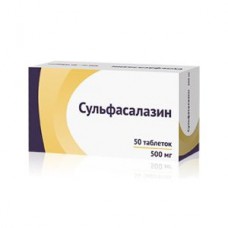Expiration date: 01/2026
Dosage form
Round, biconvex tablets, film-coated from light yellow to brownish yellow. On the cross section of the tablet, two layers are visible: the core is brownish-yellow and the film shell.
Composition:
Active substance: sulfasalazine - 500,0 mg.
Auxiliary substances: starch pregelatinization - 115,0 mg, carboximetilkrahmal sodium - 29,0 mg, povidone-K25 - 24,0 mg of magnesium stearate and 7.0 mg silica colloidal anhydrous to 5.0 mg.
Shell composition: hypromellose - 8.4 mg, macrogol-4000 - 2.1 mg, titanium dioxide - 4.1 mg, iron oxide yellow dye - 0.4 mg.
Pharmacological action
Sulfasalazine selectively accumulates in the connective tissue of the intestine with the release of 5-aminosalicylic acid (5-ASA), which has anti-inflammatory activity, and sulfapyridine, which has antimicrobial bacteriostatic activity. Pharmacokinetics About 30% sulfasalazine tablets, film-coated, absorbed from the small intestine, the remaining 70% are split intestinal microflora with the formation of sulpiride 60-80% and 25% 5-ASA. There are large individual differences in the maximum serum concentrations (Cmax) of sulfasalazine and its metabolites, in "slow acetylators" they are higher, which increases the risk of adverse effects. Sulfasalazine reaches its maximum concentration 3-12 hours after taking film-coated tablets. Bond with plasma proteins sulfasalazina - 99%, sulfapiridina -50%, 5-ask - 43%. Sulfapiridin metabolized in the liver by hydroxylation with the formation of active metabolites, 5-ASA by acetylation. Half-life (T1/2) sulfasalazina - 5-10 h, sulfapiridina - 6-14 h, 5-ask - 0,6-1,4 h. the Intestine displays 5% sulfapiridina and 67% 5-ask, kidneys - 75-91% of absorbed sulfasalazina (within 3 days).
Side effect
Side effects are associated with the degree of plasma concentration of sulfapyridine, especially in people with slow acetylation. More often side effects are observed in patients with rheumatoid arthritis. From the Central and peripheral nervous system: headache, peripheral neuropathy, dizziness, sleep disorders, hallucinations, ataxia, convulsions, depression, aseptic meningitis. From the gastrointestinal tract: nausea, vomiting, diarrhea, decreased appetite, pancreatitis, stomatitis, abdominal pain, medicinal hepatitis. From the hematopoietic organs: macrocytosis, leukopenia, neutropenia, megaloblastic anemia, hemolytic anemia, hemolytic anemia due to enzyme disorders - with unstable hemoglobin molecules (Heinz-Ehrlich body), methemoglobinemia, agranulocytosis, thrombocytopenia, aplastic anemia, hypoprothrombinemia.
From the genitourinary system: proteinuria, hematuria, crystalluria, nephrotic syndrome, transient oligospermia and male infertility.
Respiratory system: shortness of breath, cough, interstitial pneumonitis, fibrosing alveolitis, infiltrates in the lung tissue.
From the senses: tinnitus. Laboratory data: hyperbilirubinemia, increased activity of alkaline phosphatase, "hepatic" transaminases.
Allergic reaction:
generalized skin rash, urticaria, erythema, skin itching, exfoliative dermatitis, photosensitization, malignant exudative erythema (Stevens-Johnson syndrome), toxic epidermal necrolysis (Lyell syndrome), fever, lymphadenopathy, serum disease, periorbital edema, eosinophilia, nodular periarteritis, anaphylactic shock.
Other: hyperthermia, mumps, possible staining of urine, skin or soft contact lenses in yellow-orange color. Features of sale prescription
Special conditions
During treatment recommended: periodic monitoring of the activity of "hepatic" enzymes in blood plasma, a General blood test (at the beginning of therapy: 1-2 times a month, then every 3-6 months of treatment) and urine analysis (in renal failure), the use of increased amounts of fluid. Sulfasalazine is recommended to be used with caution in patients with systemic forms of juvenile rheumatoid arthritis, as there is a risk of undesirable effects, including serum disease (fever, nausea, vomiting, headache, skin rash, liver dysfunction).
The effect of the drug on the ability to drive vehicles and other mechanisms: Care should be taken when driving and working with complex technical devices in connection with the possibility of dizziness.
Indications
- Ulcerative colitis (treatment of exacerbations and maintenance therapy in remission),
- Crohn's disease (light and moderate forms in the acute phase),
- rheumatoid arthritis, juvenile rheumatoid arthritis with inefficiency of non-steroidal anti-inflammatory drugs (NSAIDs).
Contraindications
- Hypersensitivity to sulfasalazine or other components of the drug, as well as sulfonamides or salicylates, - porphyria, - granulocytopenia,
- aplastic anemia,
- congenital deficiency of glucose-6-phosphate dehydrogenase (risk of jaundice),
- hepatic and/or renal failure,
- children under 10 years of age and/or weighing 35 kg or less, with chronic inflammatory bowel disease (for this dosage form and dosage),
- intestinal or urinary tract obstruction,
- children under 6 years of age with juvenile rheumatoid arthritis (efficacy and safety not established),
- the period of breastfeeding.
With caution:
Bronchial asthma, atopic dermatitis, allergic reactions in history (possible cross-allergic reactions to furosemide, thiazide diuretics, sulfonylurea derivatives, carbonic anhydrase inhibitors), systemic forms of juvenile rheumatoid arthritis (risk of serum disease), pregnancy.
Pregnancy and lactation:
During pregnancy, the appointment of the drug is possible only for strict indications and in the minimum effective dose. If the course of the disease allows, then in the last trimester of pregnancy, the drug should be discontinued (sulfasalazine displaces bilirubin from plasma proteins, thereby increasing the risk of developing nuclear jaundice and hyperbilirubinemia of newborns - toxic damage to the nerve centers of the brain). Newborns with glucose-6-phosphate dehydrogenase deficiency may develop hemolytic anemia. Sulfasalazine is normally secreted into mother's milk in very small amounts, in premature infants and children at high risk increases the risk of developing nuclear jaundice. The concentration of sulfapyridine in human milk is 40% of the concentrations in plasma of the mother. If necessary, the use of sulfasalazine during lactation breastfeeding should be discontinued.
Drug interaction
Sulfasalazine reduces the absorption of folic acid and digoxin. Increases the effect of anticoagulants, antiepileptic and oral hypoglycemic agents, as well as side effects of cytostatics, immunosuppressants, hepato-and nephrotoxic agents. Drugs that inhibit bone marrow hematopoiesis increase the risk of myelosuppression. Antibacterial agents, due to the depressing effect on the intestinal flora, reduce the effectiveness of sulfasalazine in ulcerative colitis.
Dosage
Inside, after a meal. Ulcerative colitis, Crohn's disease for Adults and children over 16 years: in the 1st day - 500 mg 4 times a day, in the 2nd - 1 g 4 times a day, in the 3rd and subsequent days - 1.5-2 g 4 times a day. After subsiding of acute clinical symptoms of ulcerative colitis, adults and adolescents and/or weighing more than 65 kg are prescribed a maintenance dose - 500 mg 3-4 times a day for several months. Children from 10 to 16 years and/or body weight from 35 to 50 kg - 500 mg 4 times a day. Supportive care for children and adolescents under 16 years and/or weighing less than 65 kg is not recommended. The maximum daily dose for adults is 8 g, for children under 16 years - 2 g. Rheumatoid arthritis and juvenile rheumatoid arthritis for Adults and children over 16 years: during the first week - 500 mg once a day, during the second - 500 mg twice a day, the third and then - 500 mg 3 times a day. The therapeutic dose can be from 1.5 to 3 g/day. The clinical effect is manifested after 6-10 weeks of therapy. The course of treatment - 6 months or more. Children from 6 to 8 years and/or body weight 20-29 kg: 1 table. 2 times a day, Children from 8 to 12 years and/or body weight 30-39 kg: 1 table. 2-3 times a day, Children from 12 to 16 years and/or body weight 40-50 kg: 1 table. 3 times a day or 2 table. 2 times a day, Children over 16 years and/or weighing more than 50 kg: 2 table. 2 times a day. The maximum daily dose for children is 2 g or 40-50 mg/kg body weight.
Overdose
Symptoms: nausea, vomiting, abdominal pain, dizziness. When using very high doses may occur: anuria, crystalluria, hematuria, symptoms of toxic damage to the Central nervous system (seizures). Treatment: symptomatic. It is necessary to provoke vomiting, to wash out the stomach, intestines, hold alkalinisation of the urine, forced diuresis. In anuria and/or renal insufficiency should limit the consumption of fluids and electrolytes.


